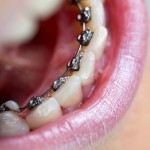
Since their introduction a number of benefits from using lingual orthodontic appliances have been claimed, less visibility, fewer white spot lesions and caries, lighter forces being required, less anchorage loss and improved comfort. Disadvantages are said to include insertion of appliances increased chairside time and laboratory costs and poorer outcomes
The aim of this review was to compare the treatment effects of lingual orthodontic appliances with labial orthodontic appliances.
Methods
Searches were conducted in the Medline, Cochrane Library, Virtual Health Library, Web of Science, Scopus, Google Scholar, ClinicalTrials.gov, and the ISRCTN registry databases with no limitations on language, or date of publication.
Parallel or split-mouth randomised and non-randomised prospective controlled trials, comparing any lingual appliance with any labial appliance and assessing therapeutic effects (both effectiveness and efficiency) or adverse effects were considered.
Initial screening and selection was carried out by one reviewer and checked by a second reviewer. Two reviewers carried out data abstraction and risk of bias assessment independently. Bias in individual studies was assessed using the Cochrane tool and overall quality was assessed using the Grading of Recommendations Assessment, Development and Evaluation (GRADE) approach. Random-effects meta-analyses were conducted, followed by subgroup and sensitivity analyses.
Results
- 11 studies involving a total of 407 patients were included, 4 RCTs (3 parallel, 1 split mouth design) 7 prospective studies.
- The majority (73%) of the lingual appliance groups and all (100%) of the labial appliance groups used prefabricated appliances.
- Serious methodological inadequacies were found in all trials for at least one bias domain
- Compared with labial appliances, lingual appliances were associated with increased overall oral discomfort, increased speech impediment (measured using auditory analysis), worse speech performance assessed by laypersons, increased eating difficulty, and decreased intermolar width.
- Lingual appliances were associated with increased intercanine width and significantly decreased anchorage loss of the maxillary first molar during space closure.
- The quality of all analyses included was judged as very low because of the high risk of bias of the included trials, inconsistency, and imprecision.
Conclusions
The authors concluded:-
Based on existing trials, there is insufficient evidence to make robust recommendations for lingual fixed orthodontic appliances regarding their therapeutic or adverse effects, as the quality of evidence was low.
Comments
An earlier review by Mistakidis et al (Dental Elf – 25th Sept 2015) also looked at this topic. Their inclusion criteria were broader and they included 11 retrospective studies and 5 trials although they only considered one of those to be randomised. Three of the studies included by Mistakidis were included in the present review. While this review suggests some positive outcomes from lingual appliances, as does the earlier review, both raise concerns regarding the quality of the available evidence to support the effectiveness of lingual appliance therapy. Ideally high quality randomised controlled trials should be conducted that include assessment of patient focused outcomes as well as adverse effects.
Links
Primary paper
Papageorgiou SN, Gölz L, Jäger A, Eliades T, Bourauel C. Lingual vs. labial fixed orthodontic appliances: systematic review and meta-analysis of treatment effects. Eur J Oral Sci. 2016 Apr;124(2):105-18. doi: 10.1111/eos.12250. Epub 2016 Feb 25. Review. PubMed PMID: 26916846.
Review protocol on PROSPERO database

Lingual fixed orthodontic appliances-insufficient evidence of effectiveness https://t.co/qg1y1TZvJ4
Insufficient evidence for effectiveness of lingual fixed orthodontic appliances https://t.co/qg1y1TZvJ4
Evidence for effectiveness of lingual fixed orthodontic appliances is limited https://t.co/qg1y1TZvJ4
Lingual fixed orthodontic appliances: insufficient evidence of effectiveness https://t.co/fFrS52rtNe via @sharethis
Insufficient evidence to make robust recommendations for lingual fixed orthodontic appliances https://t.co/qg1y1TZvJ4
@COECdentista we have insufficient evidence for many of the interventions that dentists provide! https://t.co/qg1y1TZvJ4
Don’t miss- lingual fixed orthodontic appliances-insufficient evidence of effectiveness https://t.co/qg1y1TZvJ4